RAK7289 LoRaWAN Network Server Guide
AWS IoT Core for LoRaWAN
Execute the following steps to set up your AWS account and permissions:
Set up Your AWS Account and Permissions
If you don't have an AWS account, refer to the AWS guide. The relevant sections are Sign up for an AWS account and Create a user and grant permissions.
Overview
The high-level steps to get started with AWS IoT Core for LoRaWAN are as follows:
- Set up Roles and Policies in IAM
- Add a Gateway (see section Add the Gateway to AWS IoT)
- Add Devices (see section Add a LoRaWAN Device to AWS IoT)
- Verify device and service profiles
- Set up a Destination to which device traffic will be routed and processed by a rule.
These steps are discussed as you browse through this guide. For additional details, refer to the AWS LoRaWAN Developer Guide.
Add the Gateway to AWS IoT
Preparation
Refer to the online guide for steps required prior to onboarding your gateway. For more details, check the software section of the datasheet.
Frequency Band Selection and Role Setup
Refer to the online guide for information on selecting an appropriate frequency band.
LoRa Frequency bands supported by RAK7289 are as follows:
- RU864
- IN865
- EU868
- US915
- AU915
- KR920
- AS923
- CN470
You can select an appropriate frequency band from the RAK store.
Add the LoRaWAN Gateway
To register the gateway with AWS IoT Core for LoRaWAN, follow the steps in the online guide under the Add a gateway using the console section.
Add a LoRaWAN Device to AWS IoT
Preparation
- Go to the datasheet to learn more about the RAK4631 WisBlock LPWAN Module.
- Follow the steps in the online guide under the Before onboarding your wireless device section, then proceed to the Add your wireless device to AWS IoT Core for LoRaWAN section.
Verify Profiles
AWS IoT Core for LoRaWAN supports device profiles and service profiles. Device profiles contain the communication and protocol parameter values the device needs to communicate with the network server. Service profiles describe the communication parameters the device needs to communicate with the application server.
Some pre-defined profiles are available for device and service profiles. Before proceeding, verify that these profile settings match the devices you will be setting up to work with AWS IoT Core for LoRaWAN. For more details, refer to the online guide under the Add profiles to AWS IoT Core for LoRaWAN section.
Proceed only if you have a device and service profile that will work for you.
Set up a Destination for Device Traffic
Because most LoRaWAN devices don't send data to AWS IoT Core for LoRaWAN in a format that can be consumed by AWS services, traffic must first be sent to a Destination. A Destination represents the AWS IoT rule that processes a device's data for use by AWS services. This AWS IoT rule contains the SQL statement that selects the device's data and the topic rule actions that send the result of the SQL statement to the services that will use it.
For more information, refer to the online guide under sections Add a destination using the console and Create an IAM role for your destinations. Also, refer to Create rules to process LoRaWAN device messages section in the online guide.
Set up the Gateway
For Additional Software References, check the following link:
Configure the Gateway Device
RAK7289 With WisGate OS 1 LoRaGateway Setting
By default, the gateway will work in Wi-Fi AP Mode, which means you can find an SSID named "RAK7289_XXXX" on your PC's Wi-Fi Network List. "XXXX" is the last two bytes of the gateway MAC address.
- To access the Web Management Platform, input the IP Address
192.168.230.1in your web browser.
No password is required to connect via Wi-Fi.
- Using your preferred web browser, input the aforementioned IP Address and you should see the same login page shown in Figure 1. Login the credentials provided below:
- Username: root
- Password: root
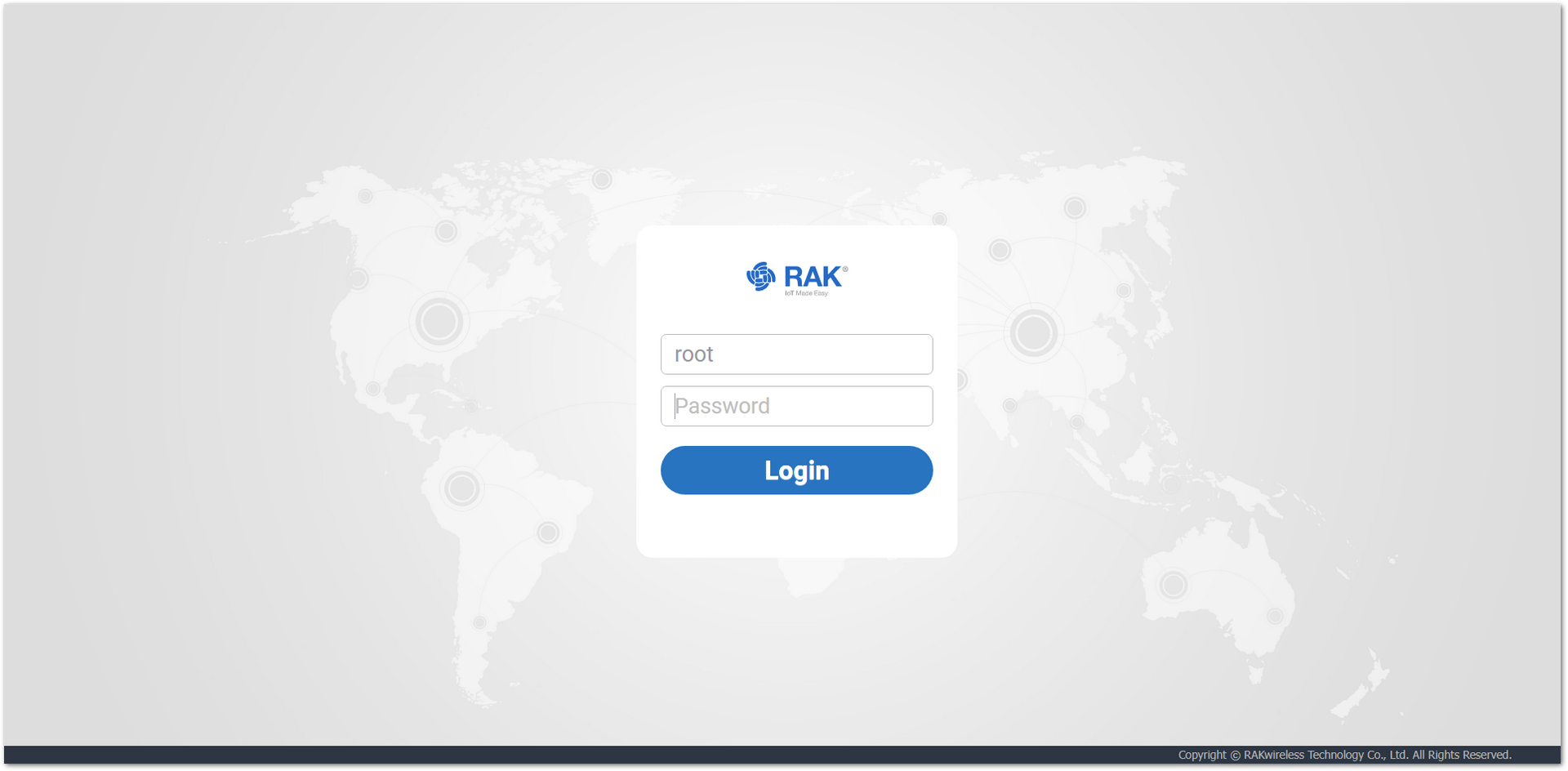 Figure 1: Login page
Figure 1: Login page-
The first firmware version that supports AWS IoT Core for LoRaWAN is 1.2.0065_Release_r209. It can be verified on Status -> Overview -> System -> Firmware Version.
-
Navigate to System -> Backup/Flash Firmware -> Flash new firmware image, and upgrade the firmware.
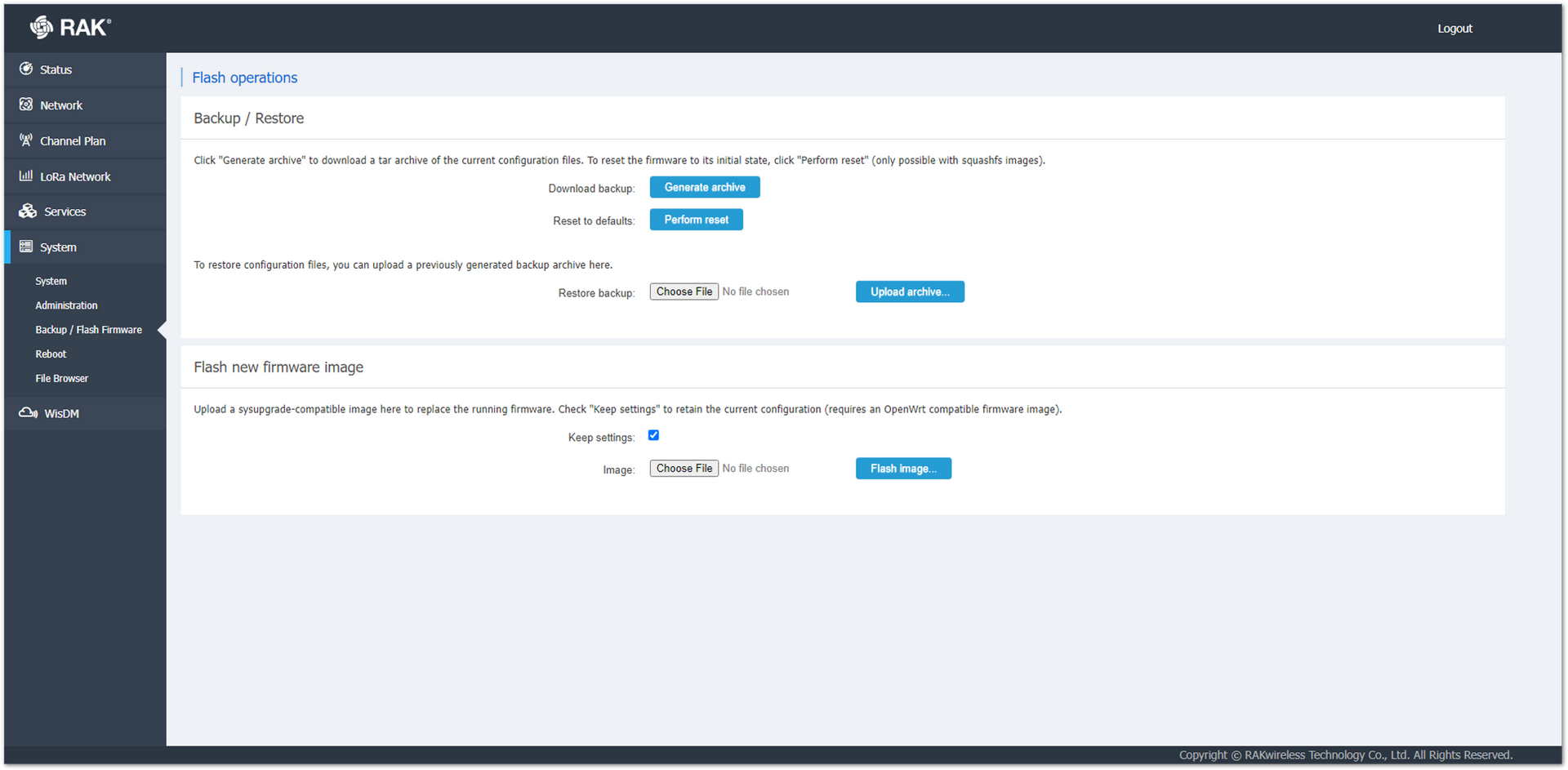 Figure 1: Flash new firmware image
Figure 1: Flash new firmware image-
Configure Network Mode to Basic Station.
- Navigate to LoRa Network -> Network Settings.
- Change Mode in LoRaWAN Network Settings to Basic Station.
- Select LNS Server from Server, then select TLS Server and Client Authentication from Authentication Mode.
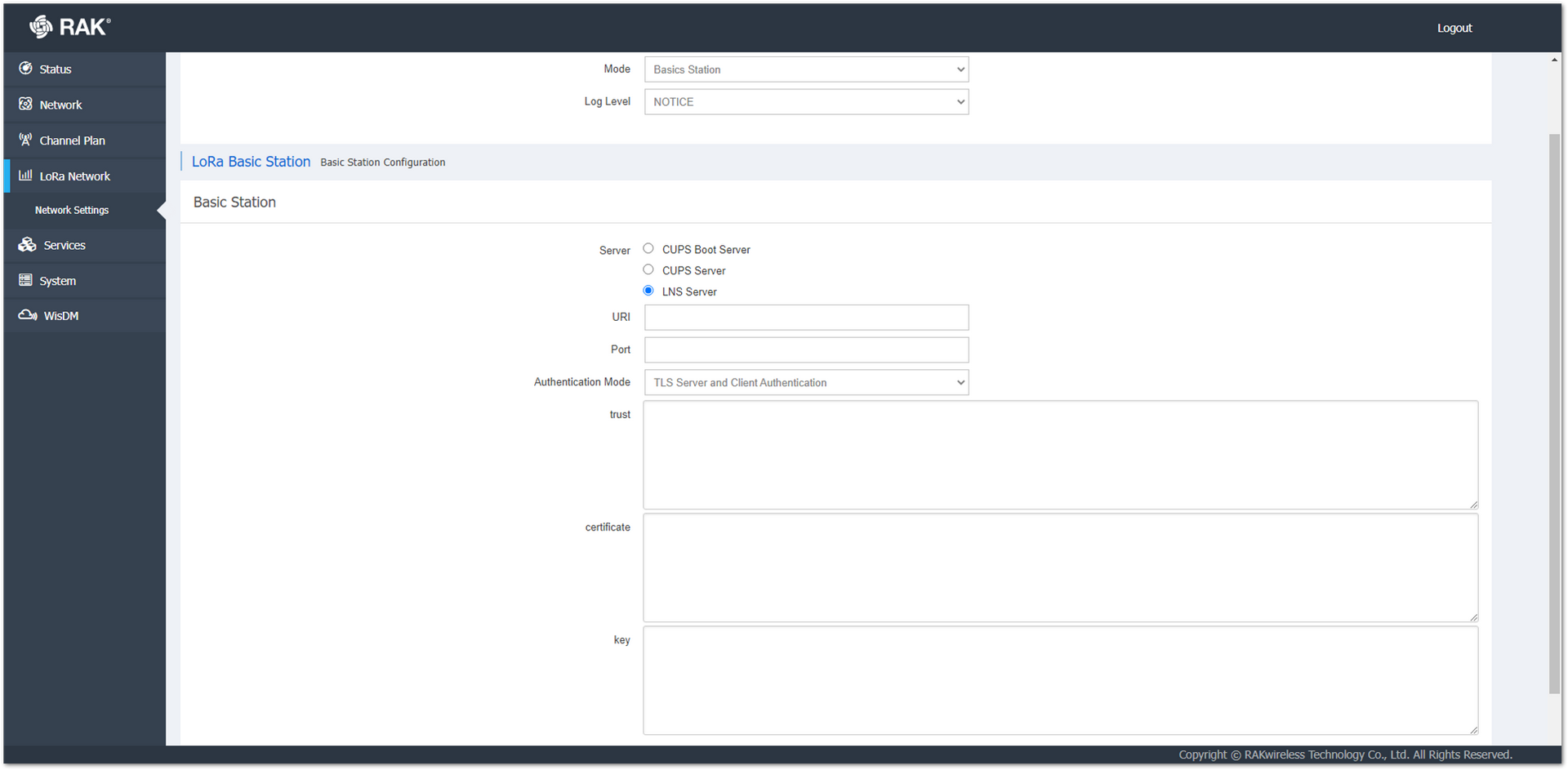 Figure 1: Configure network settings to Basic Station
Figure 1: Configure network settings to Basic Station- Configure URI, Port and Authentication Mode.
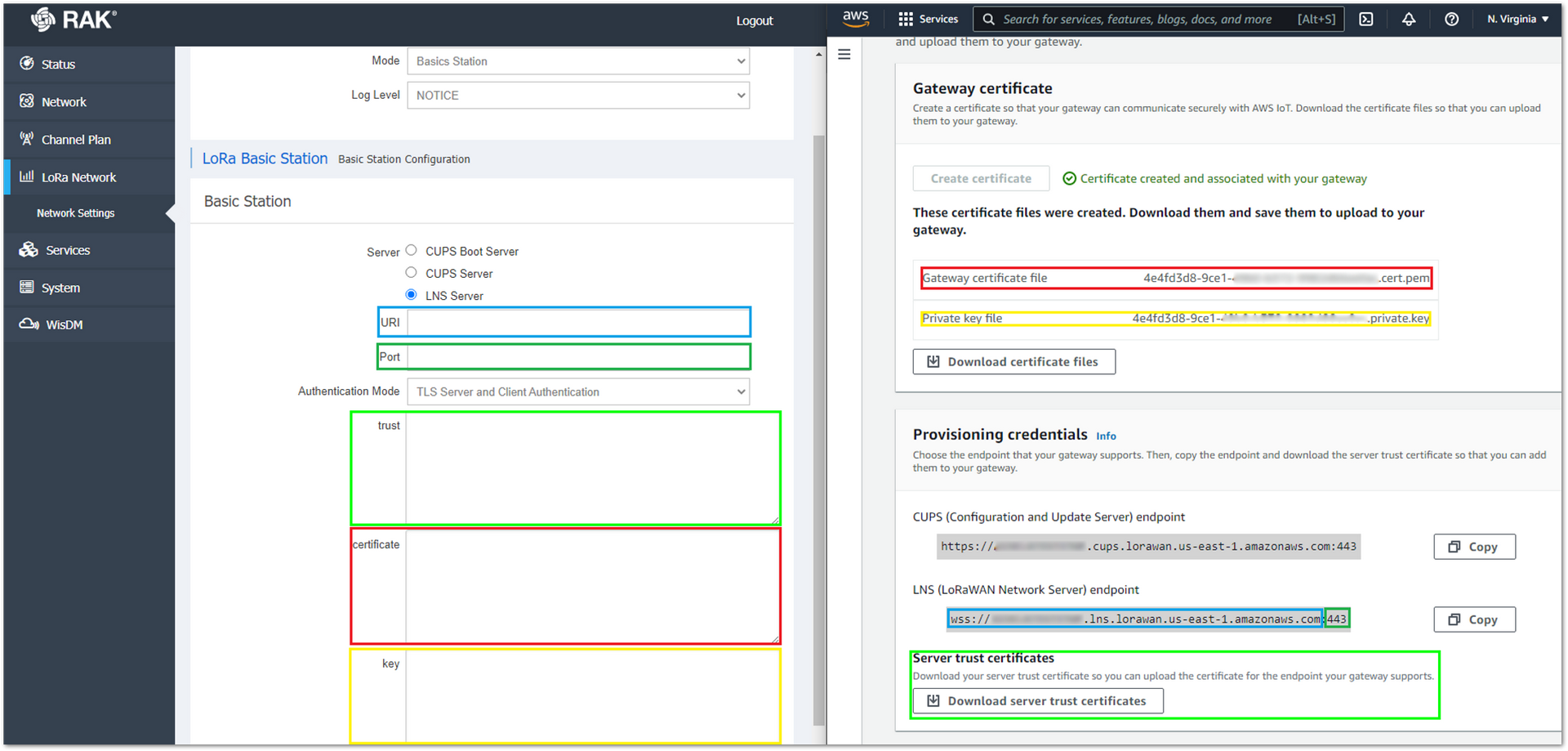 Figure 1: Configure network settings to Basic Station
Figure 1: Configure network settings to Basic StationConnect the Gateway and Verify the Connection Status
Follow the instructions in the online guide to connect your gateway to AWS IoT Core for LoRaWAN.
To verify the connection status, refer to the instructions in the Check gateway connection status using the console section.
 Figure 1: LNS server configuration
Figure 1: LNS server configurationAdd End-Devices
Refer to RAK4631 Quick Start Guide to enable communication with the gateway.
Connect the Device and Verify the Connection Status
Follow the instructions in the online guide to connect your device to AWS IoT Core for LoRaWAN.
To verify the connection status, refer to the instructions in the Check device connection status using the console section. You can also check View format of uplink messages sent from LoRaWAN devices.
Verifying Operation
Once setup is completed, provisioned OTAA devices can join the network and start to send messages. Messages from devices can then be received by AWS IoT Core for LoRaWAN and forwarded to the IoT Rules Engine.
Instructions for a sample Hello World application are given below, assuming that the device has joined and is capable of sending uplink traffic.
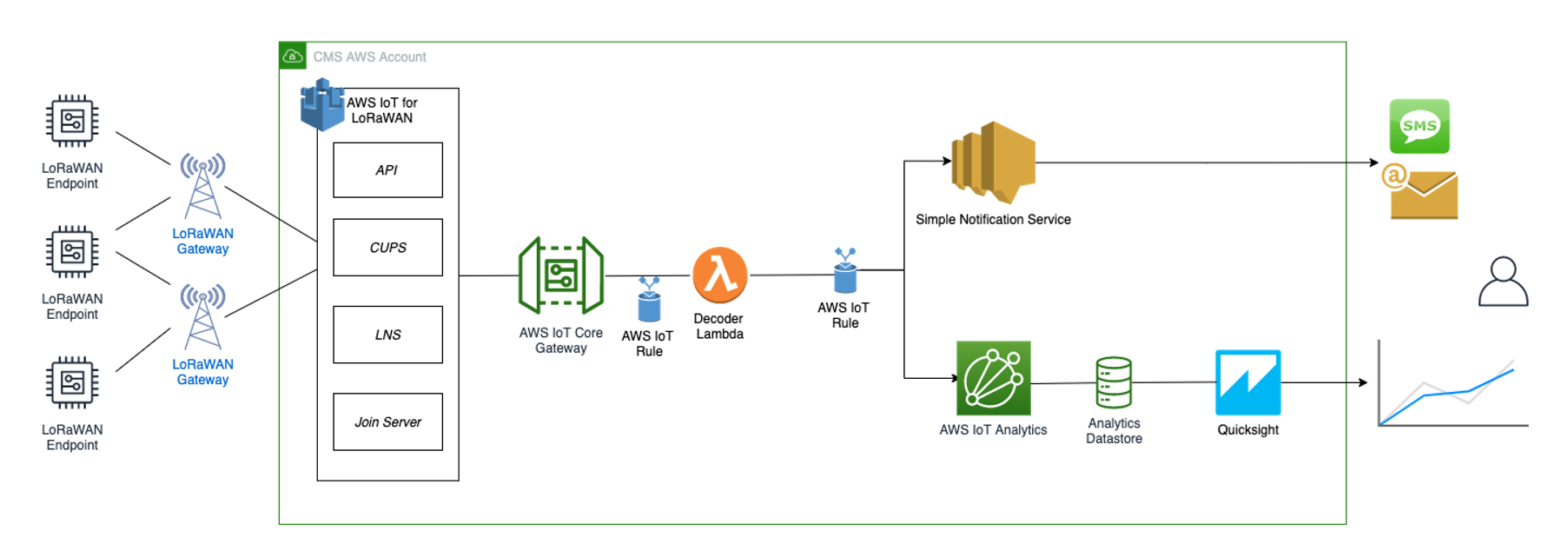 Figure 1: Sending Uplink Architecture
Figure 1: Sending Uplink ArchitectureCreate a Lambda Function for Destination Rule
Create the lambda function to process device messages processed by the destination rule.
- Go to the AWS Lambda console.
- In the navigation pane, click on Functions, then Create function.
- Select Author from scratch.
- Under Basic Information, enter the function name and choose Runtime Python 3.8. from the drop-down under Runtime.
- Click Create function.
- Under Function code, paste the copied code into the editor under the lambda_function.py tab.
import base64
import json
import logging
import ctypes
import boto3
# define function name
FUNCTION_NAME = "RAK-HelloWorld"
# Second Byte in Payload represents Data Types
# Low Power Payload Reference: https://developers.mydevices.com/cayenne/docs/lora/
DATA_TYPES = 1
# Type Temperature
TYPE_TEMP = 0x67
# setup iot-data client for boto3
client = boto3.client('iot-data')
# setup logger
logger = logging.getLogger(FUNCTION_NAME)
logger.setLevel(logging.INFO)
def decode(event):
data_base64 = event.get("PayloadData")
data_decoded = base64.b64decode(data_base64)
result = {
"devEui": event.get("WirelessMetadata").get("LoRaWAN").get("DevEui"),
"fPort": event.get("WirelessMetadata").get("LoRaWAN").get("FPort"),
"freq": event.get("WirelessMetadata").get("LoRaWAN").get("Frequency"),
"timestamp": event.get("WirelessMetadata").get("LoRaWAN").get("Timestamp")
}
if data_decoded[DATA_TYPES] == TYPE_TEMP:
temp = (data_decoded[DATA_TYPES + 1] << 8) | (data_decoded[DATA_TYPES + 2])
temp = ctypes.c_int16(temp).value
result['temperature'] = temp / 10
return result
def lambda_handler(event, context):
data = decode(event)
logger.info("Data: %s" % json.dumps(data))
response = client.publish(topic = event.get("WirelessMetadata").get("LoRaWAN").get("DevEui") + "/project/sensor/decoded", qos = 0, payload = json.dumps(data))
return response
- Once the code has been pasted, choose Deploy to deploy the lambda code.
- Click the Configuration tab of the lambda function and head to the Permissions menu.
- Change the Lambda Role Policy permission.
- Under Execution role, click on the hyperlink under Role name.
- On the Permissions tab, find the policy name and select it.
- Choose Edit policy, and choose the JSON tab.
- Append the following to the Statement section of the policy to allow publishing to AWS IoT.
{
"Effect":"Allow",
"Action":[
"iot:Publish"
],
"Resource":[
"*"
]
}- Choose Review Policy, then Save changes.
- Return to the Code tab and create a test event that will allow you to test the functionality of the lambda function.
- In the Test drop-down menu, choose Configure test events.
- Enter a name for the test event under the Event name.
- Paste the following sample payload in the area under Event name:
{
"WirelessDeviceId": "65d128ab-90dd-4668-9556-fe47c589610b",
"PayloadData": "AWf/1w==",
"WirelessMetadata": {
"LoRaWAN": {
"DataRate": "4",
"DevEui": "0000000000000088",
"FPort": 1,
"Frequency": "868100000",
"Gateways": [
{
"GatewayEui": "80029cffXXXXXXXX",
"Rssi": -109,
"Snr": 5
}
],
"Timestamp": "2021-02-08T04:00:40Z"
}
}
} - Choose Create to save the event.
- Navigate to the AWS IoT console, choose Test on the navigation pane, and select MQTT client.
- Configure the MQTT client to subscribe to "#" (all topics).
- Click on Test in the Lambda function page to generate the test event you just created.
- Verify the published data in the AWS IoT Core MQTT Test client:
- Open another window. Go to AWS IoT Console, select Test under Subscription Topic, enter # and select to Subscribe to topic.
- The output should look similar to this:
000000000000000088/project/sensor/decoded February 09, 2021, 14:45:29 (UTC+0800)
{
"devEui": "000000000000000088",
"fPort": 1,
"freq": "868100000",
"timestamp": "2021-02-08T04:00:40Z",
"temperature": -4.1
}
Create the Destination Rule
In this step, create the IoT rule that forwards the device payload to your application. This rule is associated with the destination created earlier in Set up a Destination for device traffic section.
- Navigate to the AWS IoT console.
- In the navigation pane, choose Act, then select Rules.
- On the Rules page, choose Create.
- On the Create a rule page, enter as follows:
- Name: LoRaWANRouting
- Description: Any description of your choice.
NOTEThe Name of your Rule is the information needed when you provision devices to run on AWS IoT Core for LoRaWAN.
- Leave the default Rule query statement 'SELECT * FROM 'iot/topic' unchanged. This query has no effect at this time, as traffic is currently forwarded to the rules engine based on the destination.
- Under Set one or more actions, choose Add action.
- On the Select an action page, choose Republish a message to an AWS IoT topic. Scroll down, and choose Configure action.
- On the Configure action page, for Topic, enter project/sensor/decoded.The AWS IoT Rules Engine will forward messages to this topic.
- Under Choose or create a role to grant AWS IoT access to perform this action, select Create Role.
- For Name, enter a name of your choice.
- Choose Create role to complete the role creation. You will see a "Policy Attached" tag next to the role name, indicating that the Rules Engine has been permitted to execute the action.
- Choose Add action.
- Add one more action to invoke the Lambda function. Under Set one or more actions, choose Add action.
- Choose Send a message to a Lambda function.
- Choose Configure action.
- Select the Lambda function created earlier and choose Add action.
- Then, choose Create rule.
- A "Success" message will be displayed at the top of the panel, and the destination has a rule bound to it.
You can now check that the decoded data is received and republished by AWS by triggering a condition or event on the device itself.
- Go to the AWS IoT console. In the navigation pane, select Test, and choose MQTT client.
- Subscribe to the wildcard topic # to receive messages from all topics.
- Send message from endDevice using AT command:
at+send=1:01670110. - You should see traffic similar as shown below:
393331375d387505/project/sensor/decoded February 09, 2021, 14:47:21 (UTC+0800)
{
"devEui": "393331375d387505",
"fPort": 1,
"freq": "867100000",
"timestamp": "2021-02-09T06:47:20Z",
"temperature": 27.2
}
project/sensor/decoded February 09, 2021, 14:47:21 (UTC+0800)
{
"WirelessDeviceID": "6477ec22-9570-31d5981da021",
"PayloadData": "AWcBEA==",
"WirelessMetadata": {
"LoRaWAN": {
"DataRate": "4",
"DevEui": "393331375d387505",
"FPort": 1,
"Frequency": "867100000",
"Gateways": [
{
"GatewayEui": "ac1ff09fffe014bd5",
"Rssi": -103,
"Snr": 8.5
}
],
"Timestamp": "2021-02-09T06:47:20Z"
}
}
}
Configuring Amazon SNS
You will be using the Amazon Simple Notification Service to send text messages (SMS) when certain conditions are met.
- Go to the Amazon SNS console.
- Click on the menu to open the navigation pane.
- Select Text Messaging (SMS) and choose Publish text message.
- Under the Message type, select Promotional.
- Enter your phone number (phone number that will receive text alerts).
- Enter Test message for the Message and choose Publish message.
- If the phone number you entered is valid, you will receive a text message and your phone number will be confirmed.
- Create an Amazon SNS Topic as follows:
- In the navigation pane, choose Topics.
- Select Create topic.
- Under Type, select Standard.
- Enter a name of your choice. Here, you will use
text_topic. - Choose Create topic.
- Create a subscription for this topic:
- In the page for the newly created
text_topic, choose the Subscriptions tab. - Choose Create subscription.
- In Topic ARN, choose the topic you have created earlier.
- Select Protocol as SMS from the drop-down.
- Under Endpoint, enter the previously validated phone number to receive the SMS alerts.
- Choose Create subscription. You should see a "Subscription to text_topic created successfully" message.
- In the page for the newly created
Add a Rule for Amazon SNS Notification
Now, add a new rule to send an Amazon SNS notification when certain conditions are met in a decoded message.
- Navigate to the AWS IoT console.
- In the navigation pane, choose Act, then Rules.
- On the Rules page, choose Create.
- Enter the Name as
text_alertand provide an appropriate Description. - Under the Rule query statement, enter the following query:
SELECT devEui as device_id, "Temperature exceeded 25" as message, temperature as temp, timestamp as time FROM '+/project/sensor/decoded' where temperature > 25
- Choose Add action.
- Choose Send a message as an SNS push notification.
- Choose Configure action.
- Under SNS target, select
text_topicfrom the drop-down. - Select RAW under Message format.
- Under Choose or create a role to grant AWS IoT access to perform this action, choose Create role.
- Enter a name for the role, and choose Add action.
- Select Create rule. You should see a "Success" message, indicating that the rule has been created.
Test the Rule for Amazon SNS Notification
After adding the rule for Amazon SNS notification, you should receive a text message when hitting the event.
Send message from end-device using AT command: at+send=1:01670110. Here is the message from mobile after sending an uplink message:
{
"device_id": "393331375d387505",
"message": "Temperature exceeded 25",
"temp": 27.2,
"time": "2021-02-22T07:58:54Z"
}
Send Downlink Payload
This section shows how to send downlink payload from AWS IoT LoRaWAN Server to end-device.
Install the AWS SAM CLI
Follow the instruction in the online guide to install the AWS SAM CLI.
Deploy the SAM Template to AWS
Follow the instruction in the Deploy SAM template to AWS GitHub.
Send Payload to End-Device
- Go to the AWS IoT console.
- In the navigation pane, select Test, and choose MQTT client.
- Subscribe to the wildcard topic # to receive messages from all topics.
- Specify the topic to
cmd/downlink/{WirelessDeviceId}and a base64-encoded message.
 Figure 1: Specifying a topic
Figure 1: Specifying a topic- You should see traffic on AWS similar as shown below:
downlink/status/6477ec22-9570-4fea-9668-31d5981da021 February 09, 2021, 15:09:29 (UTC+0800)
{
"sendresult": {
"status": 200,
"RequestId": "4f1d36e1-8316-4436-8e9d-2207e3711755",
"MessageId": "60223529-0011d9f5-0095-0008",
"ParameterTrace": {
"PayloadDate": "QQ==",
"WirelessDeviceId": "6477ec22-9570-4fea-9668-31d5981da021",
"Fport": 1,
"TransmitMode": 1
}
}
}
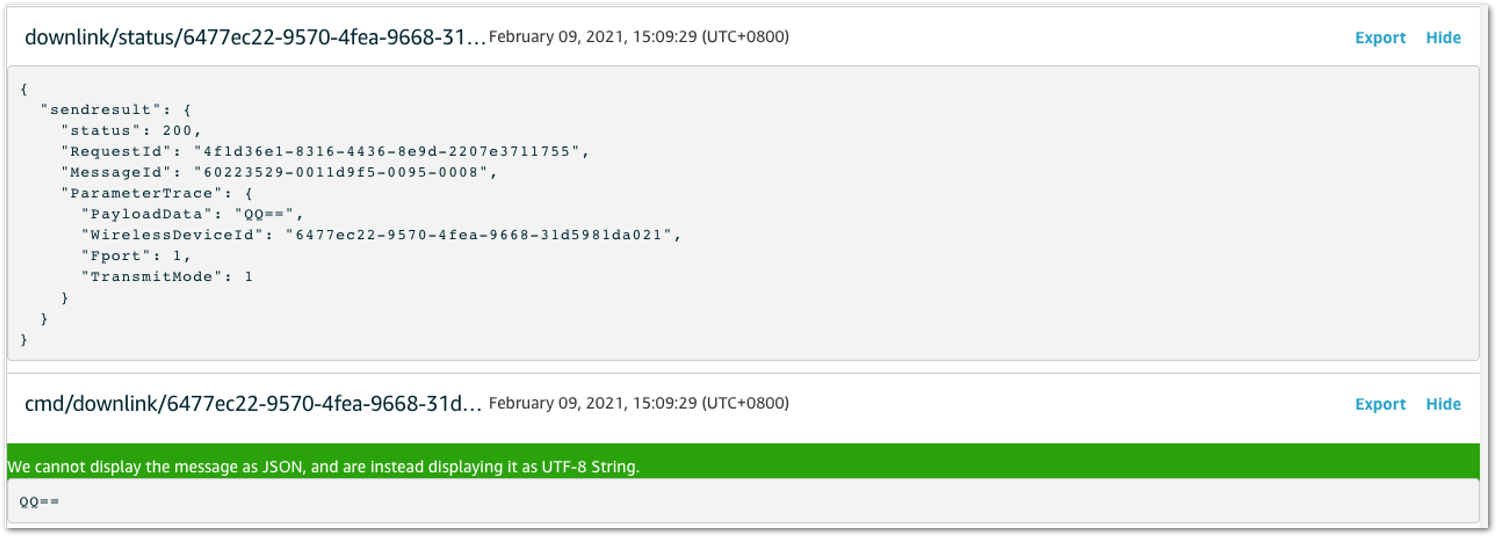 Figure 1: Traffic on AWS
Figure 1: Traffic on AWS- You should see traffic on your console of end-device similar as shown below:
SYSLOG:4:LoRa rX : 41 - 14
SYSLOG:4:LoRa Tx :
IoT Analytics
You will use IoT Analytics to visually display data via graphs if there is a need in the future to do further analysis.
Create an IoT Analytics Rule
Create a Rule First- Navigate to the AWS IoT console.
- In the navigation pane, choose Act and then, choose Rules.
- On the Rules page, choose Create.
- Enter the Name as Visualize and provide an appropriate Description.
- Under the Rule query statement, enter the following query:
SELECT * FROM 'project/sensor/decoded' - Choose Add action.
- Select Send a message to IoT Analytics.
- Choose Configure Action.
- Choose Quick Create IoT Analytics Resources.
- Under Resource Prefix, enter an appropriate prefix for your resources, such as LoRa Choose Quick Create.
- Once the Quick Create Finished message is displayed, choose Add action.
- Choose Create rule. You should see a Success message, indicating that the rule has been created.
Configure AWS IoT Analytics
Set Up AWS IoT Analytics- Go to the AWS IoT Analytics console.
- In the navigation panel, choose Data sets.
- Select the data set generated by the Quick Create in Create an IoT Analytics Rule.
- In the Details section, edit the SQL query.
- Replace the query with as follows:
SELECT devEui as device_id, temperature as temp, timestamp as time FROM LoRa_datastore - Under Schedule, choose Add schedule.
- Under Frequency, choose Every 1 minute, and then click Save.
Configure Amazon QuickSight
Amazon QuickSight lets you easily create and publish interactive BI dashboards that include Machine Learning-powered insights.
- Go to AWS Management console.
- From the management console, enter QuickSight in the "Search for services, features.." search box.
- Click on QuickSight in the search results.
- If you haven't signed up for the service before, go ahead and sign up, as there is a free trial period.
- Select the Standard Edition, and choose Continue.
- Enter a unique name in the field QuickSight account name.
- Fill in the Notification email address.
- Review the other checkbox options and change them as necessary. The AWS IoT Analytics option must be selected.
- Choose Finish. You will see a confirmation message.
- Choose Go to Amazon QuickSight.
- Select Datasets.
- Select New dataset.
- Select AWS IoT Analytics.
- Under Select an AWS IoT Analytics data set to import, choose the data set created in Create an IoT Analytics Rule.
- Choose Create data source, and then choose Visualize.
- Select the dataset created, then select Refresh or Schedule Refresh for a periodic refresh of the dataset.
Testing Your "Hello Word" Application
Using your device, create a condition to generate an event such as a high-temperature condition. If the temperature is above the configured threshold, then you will receive a text alert on your phone. This alert will include key parameters about the alert.
You can also visualize the data set as follows:
- Go to the AWS IoT Analytics console.
- Choose Data sets.
- Select the dataset created earlier.
- Select Content and ensure there are at least few uplink entries available in the data set.
- Go to the QuickSight console.
- Choose New analysis.
- Choose the dataset created in Create an IoT Analytics Rule.
- To see a chart of your dataset, select the following values:
- Time on the X-axis
- Value as temp (Average)
- Color as device_id.
Debugging
If you experience any issues, you can check the logs located in the /var/log/ directory.
Troubleshooting
- Unable to see the web login:
- Check that your wifi is connected to RAK7Wireless_XXXX.
- Try ping 192.168.230.1.
The Things Network v3 (TTNv3)
In this section, it will be shown how to connect RAK7289 WisGate Edge Pro to TTNv3.
To login into the TTNv3, head on here. If you already have a TTN account, you can use your The Things ID credentials to log in.
 Figure 1: The Things Stack Home Page
Figure 1: The Things Stack Home PageThis tutorial is for the EU868 Frequency band.
Registering the Gateway
- To register a commercial gateway, choose Register a gateway (for new users that do not already have a registered gateway) or go to Gateways > + Add gateway (for users that have registered gateways before).
 Figure 1: Console Page after successful login
Figure 1: Console Page after successful login-
You will be redirected to the Register gateway page.
-
In the Gateway EUI field type the EUI of the gateway. The gateway's EUI can be found either on the sticker on the casing or by going to the LoRa Network Settings page in the LoRa Gateway menu accessible via the Web UI. Instructions on how to access your gateway via Web UI can be found in the product's Quickstart Guide.
 Figure 1: Register gateway
Figure 1: Register gateway- After typing the EUI, click on Confirm. Additional fields will pop up. Fill in the following information:
-
Gateway ID – This will be the unique ID of your gateway in the Network. An ID based on the EUI is automatically generated. You can changed it if you need. Note that the ID must contain only lowercase letters, numbers, and dashes (-).
-
Gateway name – Optionally, you can type a name for your gateway.
-
Frequency plan - The frequency plan used by the gateway.
For this tutorial, we will use Europe 863-870 MHz (SF12 for RX2).
- The other settings are optional and can be changed to satisfy your requirements.
 Figure 1: Adding a gateway
Figure 1: Adding a gateway- To register your gateway click Register gateway.
 Figure 1: Successfully added gateway
Figure 1: Successfully added gatewayTTNv3 supports TLS server authentication and Client token, which requires a trust file and a key file to configure the Gateway to successfully connect it to the network.
Generating the Token
- To generate a key file, from the Overview page of the registered Gateway navigate to API keys.
 Figure 1: Overview page
Figure 1: Overview page- On the API keys page, choose + Add API key.
 Figure 1: API key page
Figure 1: API key page- In the Name field type the name of your key (for example - mykey). Choose Grant individual rights and select Link as Gateway to a Gateway for traffic exchange, i.e. read uplink and write downlink.
 Figure 1: Generating an API key
Figure 1: Generating an API key- To generate the key, choose Create API key. The following window will pop up, telling you to copy the key you just generated.
 Figure 1: Copying the generated key
Figure 1: Copying the generated keyCopy the key and save it in a .txt file (or other), because you won’t be able to view or copy your key after that.
- Click I have copied the key to proceed.
Configuring the Gateway
-
To configure the gateway access it via the Web UI. To learn how to do that check out the device's Quickstart Guide mentioned before.
-
Navigate to LoRa Network > Network Settings > Mode drop-down menu > choose Basics Station.
 Figure 1: Changing the working mode
Figure 1: Changing the working mode- Select Switch mode to apply the change. After that, the Basics Station Configuration pane settings will show up. To connect the Gateway to TTNv3, the following parameters must be configured:
- Server – For server choose LNS Server.
- URI – This is the link to The Things Stack server. Note that, for this tutorial, we are connecting the gateway to the European cluster. For Europe fill in the following: wss://eu1.cloud.thethings.network
- Port �– The LNS Server uses port 8887. Type in 8887.
- Authentication Mode – Choose TLS server authentication and Client token. When selected, the trust and the token field will show up.
- trust – For trust we will use the Let’s Encrypt ISRG ROOT X1 Trust certificate. The file with the certificate can be found here.
- token - This is the generated API key. The key must start with Authorization:. Example:
Authorization: YOUR_API_KEY
Replace YOUR_API_KEY with the key generated previously. Have in mind that there should be a “space” between Authorization: and YOUR_API_KEY, as shown in the example.
 Figure 1: LoRa Basics Station settings
Figure 1: LoRa Basics Station settings- To save the changes click Save & Apply.
You can now see that your gateway is connected to TTNv3 as Basics Station:
 Figure 1: Successful connection
Figure 1: Successful connectionThingPark by Actility
In this section, you will learn how to add RAK7289 WisGate Edge Pro in ThingPark.
ThingPark is Actility’s platform, in which you can register your LoRaWAN gateway and end devices. ThingPark offers a user-friendly dashboard, in which you can monitor different information about the gateway/end device like status, radio traffic, statistics, and more. Together with HTTPS integration, you can send the data received from the end nodes to an Application server for post-processing and visualizing.
For the complete step-by-step tutorial, refer to the How to Add RAK WisGate Edge Gateway in ThingPark - Actility ThingPark Guide.
